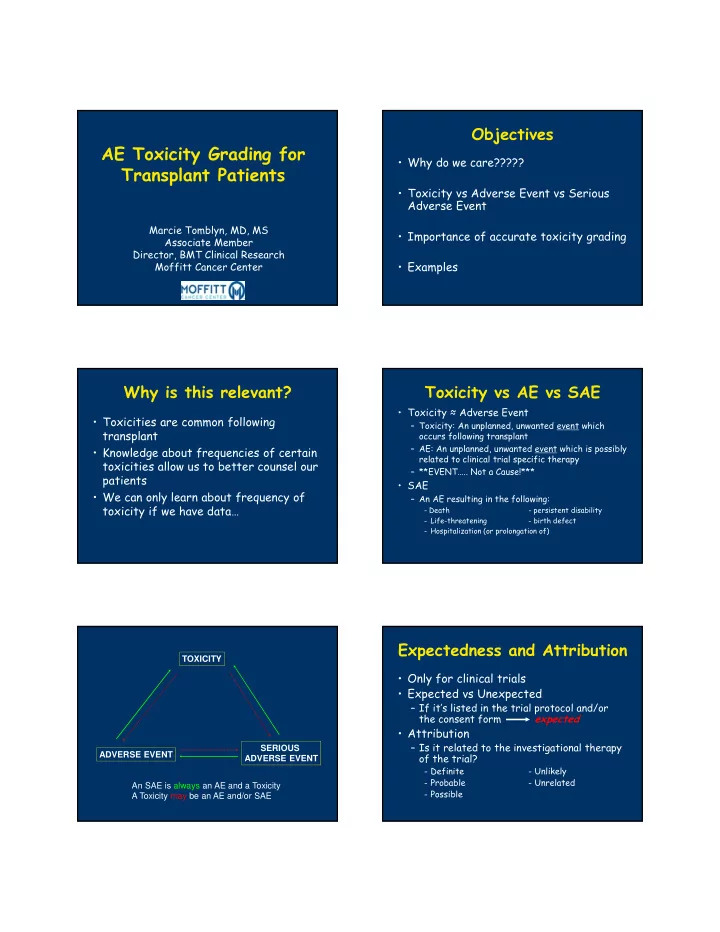

Objectives AE Toxicity Grading for • Why do we care????? Transplant Patients • Toxicity vs Adverse Event vs Serious Adverse Event Marcie Tomblyn, MD, MS • Importance of accurate toxicity grading Associate Member Director, BMT Clinical Research • Examples Moffitt Cancer Center Why is this relevant? Toxicity vs AE vs SAE • Toxicity ≈ Adverse Event • Toxicities are common following – Toxicity: An unplanned, unwanted event which transplant occurs following transplant – AE: An unplanned, unwanted event which is possibly • Knowledge about frequencies of certain related to clinical trial specific therapy toxicities allow us to better counsel our – **EVENT….. Not a Cause!*** patients • SAE • We can only learn about frequency of – An AE resulting in the following: toxicity if we have data… - Death - persistent disability - Life-threatening - birth defect - Hospitalization (or prolongation of) Expectedness and Attribution TOXICITY • Only for clinical trials • Expected vs Unexpected – If it’s listed in the trial protocol and/or the consent form expected • Attribution – Is it related to the investigational therapy SERIOUS ADVERSE EVENT of the trial? ADVERSE EVENT - Definite - Unlikely - Probable - Unrelated An SAE is always an AE and a Toxicity - Possible A Toxicity may be an AE and/or SAE
Toxicity Grading • Common Terminology Criteria Adverse Events – Developed by NCI – Currently on Version 4.03 • Significantly different than v 3.0 – Available at http://evs.nci.nih.gov/ftp1/CTCAE/CTCAE_ 4.03_2010-06-4_QuickReference_5x7.pdf Grading Scale Common Toxicities after HCT • 0: no AE or within normal limits • “Common”—occur in >20% of patients • 1: mild • Should be easily recognized and graded • 2: moderate • Examples: • 3: severe Nausea Neutropenic fever Vomiting Fatigue • 4: life-threatening/disabling Diarrhea Electrolyte disturbances • 5: fatal Mucositis Pancytopenia requiring transfusions Grading Toxicities during Transplant “Less Common” toxicities • Most toxicities change severity day to day…… • Many other issues with our transplant sometimes hour to hour! • Assessments often look for most severe in a patients block of time • Consider assessment by organ systems – Ex. Most severe grade of oral mucositis between – Pulmonary day 0 – day 7 – Ideally, assess about the same time each day – Cardiac during HCT – Hepatic • Reporting differs based on indication for – GU report: daily nurse assessments vs clinical research vs registry reporting • Still assess with CTC AE criteria
Example What are the toxicities to be graded and what are the • 33 yo M with ALL now day +8 after MUD HCT with Flu/Bu conditioning and grades? Tac/MTX for GvHD prophylaxis • Temp 101.3F, BP 92/57, HR 124, RR 24, What other information do O2 sat 90% on RA and inc to 97% with 2 LPM/NC you need to assist in • PE: A&O x4, tachycardic and grading? tachypneic, crackles at the bases bilaterally, abdomen bland, no rash Toxicities which could be Example, cont graded…. • Fever… is patient neutropenic? • Patient is now day +10 – ANC < 500/mcL • He is unable to eat due to mouth pain • Hypotension… what is the baseline BP? and exam shows an ulcer on the tongue and some mild mucosal bleeding – 100’s/60’s • Blood cultures from day +8 grew • Tachycardia Streptococcus viridans and he is on • Hypoxia appropriate antibiotics without additional fevers and no longer requiring O2 CIBMTR Registry Trial Reporting (CTN/RCI BMT) • CIBMTR (registry) • Does it fall into a “clinically significant” infection category? – Report the infection on form 2100
Example, cont CIBMTR Reporting • Now day +16 with an ANC of 600/mcL • Bilirubin increasing to 3.4 with abdominal distension and weight has increased to 96kg from admission of 90kg • A RUQ ultrasound demonstrates reversal of flow c/w VOD/SOS and ascites CIBMTR Reporting Trial Reporting (CTN/RCI BMT • Toxicity forms are time-point driven – D30, d60, d100, d180, etc • Asks not only symptoms but requests potential etiologies Example, cont Example, cont • On day +22, he develops a confluent • Patient has a skin biopsy and EGD/Flex maculopapular erythematous rash on his sig to assess for GVHD face, back, chest, abdomen, and arms – Skin: consistent with GVHD • His bilirubin is now 4.2 and his – Rectal biopsy with path 3/4 GVHD creatinine is 1.6 – Gastric biopsy with path 1/4 GVHD • Stool cultures are also sent for • He has started having diarrhea, about 6 infectious etiology stools per day, with a volume of about 800 mL – Negative
CIBMTR Reporting Rule of Nines chart to assess percent BSA involved with a rash Trial Reporting (CTN/RCI BMT) • GVHD – Weekly assessments for reporting aGVHD – Clinical diagnosis with pathologic confirmation – Organ STAGE and Overall GRADE Summary • Toxicities – Signs and Symptoms – Not etiologies • Clear criteria for assessment – Available on-line in a searchable PDF • Reporting of toxicities varies based on reasons for assessment
Recommend
More recommend